
The common thread in all the success stories we’ve seen is demonstrating the business-critical impact L&D teams have.
by Robin Nichols
March 2, 2022
Employees are rethinking their relationships with their jobs. Amid the Great Resignation, people are asking themselves questions like, “Is this really the career I want? Am I getting everything I want out of this job? Do I like my work-life balance?”
And it’s no different for learning and development professionals. In this climate of self-questioning, you might very well be asking yourself if you’re happy in your current role. Perhaps you’d like to try out working in L&D — or leave it behind. Or maybe you’re ready to take on more responsibility as an L&D professional, but not sure how to make your case.
At 360Learning, we spend a lot of time figuring out what L&D professionals need to excel in their work. After speaking with our clients, peers and our own L&D team, we’ve got a pretty good idea of what it takes to thrive in the field of L&D.
In a phrase? Stop focusing on outputs and “training people,” and start focusing on outcomes, changing mindsets and seeing your work as a business driver.
Is L&D right for you?
Many people take a long, hard look in the mirror and come away saying, “I don’t like my job.”
Cassie Naji, currently director of L&D at content marketing agency Animalz, knows this topic intimately. We spoke with Naji to better understand what motivated her to switch from a role as a content marketer and strategist and carve out a space for herself as Animalz’ first L&D hire.
One thing we asked her about were the qualities needed to be successful in L&D. Her answer centered on motivation: “I think the must-have factor for an L&D person is to care deeply about your team’s growth and your company’s growth. That’s the biggest pattern I’ve seen so far,” she says.
Audrey Jarre, 360Learning’s senior learning manager, shares a similar viewpoint. Jarre, like Naji, moved internally from another team to take on an L&D position. “I thought that my next step would be in learning and development. And if I couldn’t get it here [at 360Learning], I had to leave and do it somewhere else,” she says. “However, I feel like you can’t enjoy learning and development in a company that you’re not fully aligned with, culture-wise, because it’s through learning that you drive culture.”
For both Jarre and Naji, caring about the big picture of an organization — its culture, growth and all of its individual contributors — is fundamental.
We’ll see how critical this ability of connecting individual L&D initiatives to the macro-goals of a business is when you’re looking to move your career forward.
Taking the first step
There’s a strong argument to be made for moving laterally in your current organization instead of looking for an open role at another organization. After all, you probably already know the people, processes and culture, which will give you a big leg up, and you’ve already proven yourself in your current position.
This was the case for both Jarre and Naji, and it gave them a huge advantage. As Naji explained, “having also done two of the main roles we have at the agency helps me understand skills gaps and training needs.” For Audrey, having been a team lead on the learning engagement coach team, she was intimately familiar with 360Learning’s clients, culture, platform and vision around Collaborative Learning, which the hiring manager admitted was an asset.
But the path to L&D wasn’t the same for both women. In Naji’s case, no L&D team existed at Animalz, so she was in the unique position of having to both pitch the new role to leadership, and herself as the best candidate. For Jarre, 360Learning’s Head of Learning knew he wanted to hire a generalist for an L&D position, and so she had to contend with outside and internal competition.
In both cases, proving their business impact was imperative to them getting (and keeping) the job.
Naji worked closely with Animalz’s chief operating officer to flesh out the details for upper management:
“We broke out the possible financial benefits for the company of me hitting certain KPIs in an L&D role, as well as looking at the cost of having to replace me, realistic timelines, etc. That was really helpful because it also formed part of the eventual OKRs for the L&D job, the first at the agency. That business-first framing helped shift the conversation from something I wanted to do, to something that the company needed and could benefit from” she says.
Making the argument that opening the L&D role would move the needle in clear, measurable ways on bottom-line issues — and also outlining what the company would lose out on if she left — was at the heart of Naji’s success.
And even if Jarre didn’t have to fight to open the role, she does have to prove they made the right choice, once she’s there. Like at Animalz, everyone at 360Learning uses an OKR framework for performance appraisal. If done right, this ensures that everyone’s work visibly contributes to an overarching business goal, whether that’s bringing in new clients, strengthening employee retention, or improving customer satisfaction.
One of Jarre’s most important tasks during her first month in this new role is to establish OKRs that will demonstrate her visible impact on these wider goals — fast. She explained the particularities of this situation:
“Because I’m moving from a position that was inside a company, his expectations are quite different. And I feel that everyone is expecting me to deliver from day one with the same level of quality that I had been delivering in my previous job, although it’s an entirely different type of work. This somehow makes me a bit stressed out, although it’s exhilarating,” she says.
One thing is clear: Whether upper management is already on board with hiring an L&D role or you have to make the case yourself, it’s imperative to clearly demonstrate, within a given timeframe, the measurable impact you could have in that role on wider business goals.
How do you climb the ranks to become a CLO?
Indeed, for those who’re already working in L&D, this is the key to success for moving up the ranks, potentially to a C-suite role as a Chief Learning Officer. With the current disruption in the jobs market and the need to upskill, reskill and hang on to talent, the door is open for aspiring L&D professionals to make their case for the CLO role.
In order to make the shift to CLO, L&D leaders need to reimagine their scopes. They are no longer playing a supporting role, but are driving business-critical metrics.
For many L&D executives, a shift in mindset is needed: Instead of zeroing in on micro-metrics such as courses completed or engagement rates, they should see themselves as shaping how their learners think and approach problems and challenges. “Teach a man to fish,” in other words.
Naji sums up this outlook nicely: “My job is not to train people; my job is to empower the team to improve business outcomes. Having a deep understanding of our business model, our challenges, etc., keeps me focused on outcomes, not outputs in L&D. I’m pretty relentlessly focused on business data and L&D’s impact on it. I don’t track bums-on-seats, training video engagement metrics, or things like that. I track production, churn, quality, and associated metrics,” she says.
Jarre takes a similar approach. Her first main mission in her new role is to revamp the company’s onboarding program. This course is pivotal to 360Learning, since it teaches new hires how to think, problem-solve and communicate in their new environment, and has a direct impact on metrics like churn and employee satisfaction.
The first-ever CLO
This big-picture view is exactly the approach that the first-ever CLO, Steve Kerr, took to establishing the role at General Electric.
When he was hired in 1994, there was no job description, and he himself worked on inventing the title of “Chief Learning Officer.” Jack Welch, GE’s CEO, told him that his main mission was, “to move information from outside in, from one business to another, and from one region to another. Make sure information is applicable, make sure it is portable and make sure it is useful.”
This led Kerr to understand that information wasn’t flowing because of a lack of ability and motivation on the part of employees. So he went about building processes to change their mindset; he rewarded people for sharing helpful information and punished those that hoarded it. His approach was successful; a culture of sharing knowledge took root at GE, and the role of CLO was propelled into the business world.
In order to make these kinds of sweeping changes that define the scope of the CLO, you’ll need to work out the most important impact learning can have on your entire organization, and how you can tactically achieve that change. We’ve determined the five main steps this involves, which we’ve outlined briefly below:
- Create a CLO mission statement that aligns with corporate strategy. This is where you aim high and assert the fundamental impact learning has on the organization’s bottom line.
- Create a strategic framework and roadmap. Broadly speaking, how will you and your team attain your mission? Share your high-level roadmap.
- Define the CLO governance model. Which stakeholders will support and oversee the roadmap — who will be doing what to ensure its success?
- Build a CLO organization that is both hybrid and agile. It’s important to ensure your setup can automate repetitive tasks and bend with changing business circumstances.
- Implement the right tools and processes. Do you have the right platforms and mechanisms needed to support your roadmap and mission?

An example of a CLO mission statement.
Final thoughts
The common thread in all the success stories we’ve seen is demonstrating the business-critical impact L&D teams have. This is true if you’re just starting out and fighting to be your company’s first L&D hire, or if you’re vying for a seat with the C-suite. This means reassessing how you view yourself and your own scope — moving away from that of a supporting role, tracking outputs like number of courses created, to a growth engine with measurable impact on high-level business goals.




